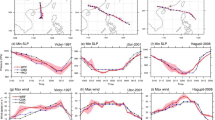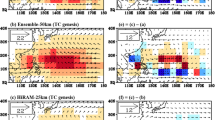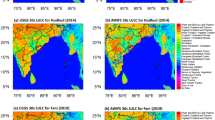Abstract
A numerical method is developed using a regional climate model (RegCM3) and the Weather Forecast and Research (WRF) model to predict seasonal tropical cyclone (TC) intensities at landfall for the South China region. In designing the model system, three sensitivity tests have been performed to identify the optimal choice of the RegCM3 model domain, WRF horizontal resolution and WRF physics packages. Driven from the National Centers for Environmental Prediction Climate Forecast System Reanalysis dataset, the model system can produce a reasonable distribution of TC intensities at landfall on a seasonal scale. Analyses of the model output suggest that the strength and extent of the subtropical ridge in the East China Sea are crucial to simulating TC landfalls in the Guangdong and Hainan provinces. This study demonstrates the potential for predicting TC intensities at landfall on a seasonal basis as well as projecting future climate changes using numerical models.














Similar content being viewed by others
References
Anderson JL (1996) A method for producing and evaluating probabilistic forecasts from ensemble model integrations. J Clim 9(7):1518–1530
Au-Yeung AYM, Chan JCL (2012) Potential use of a regional climate model in seasonal tropical cyclone activity predictions in the Western North Pacific. Clim Dyn 39(3–4):783–794
Bhaskaran B, Ramachandran A, Jones R, Moufouma-Okia W (2012) Regional climate model applications on sub-regional scales over the indian monsoon region: the role of domain size on downscaling uncertainty. J Geophys Res D117(10):D10,113
Camargo SJ, Sobel AH (2005) Western North Pacific tropical cyclone intensity and ENSO. J Clim 18(15):2996–3006
Chan JCL (1985) Tropical cyclone activity in the Northwest Pacific in relation to the El Niño/Southern Oscillation phenomenon. Mon Weather Rev 113(4):599–606
Chan JCL (2000) Tropical cyclone activity over the Western North Pacific associated with El Niño and La Niña events. J Clim 13(16):2960–2972
Chan JCL, Gray WM (1982) Tropical cyclone movement and surrounding flow relationships. Mon Weather Rev 110(10):1354–1374
Chan JCL, Xu M (2009) Inter-annual and inter-decadal variations of landfalling tropical cyclones in East Asia. Part I: time series analysis. Int J Climatol 29(9):1285–1293
Chan JCL, Shi JE, Lam CM (1998) Seasonal forecasting of tropical cyclone activity over the Western North Pacific and the South China Sea. Weather Forecast 13(4):997–1004
Chow KC, Chan JCL, Pal JS, Giorgi F (2006) Convection suppression criteria applied to the MIT cumulus parameterization scheme for simulating the Asian summer monsoon. Geophys Res Lett 33(24):L24,709
Chu JH, Sampson CR, Levine AS, Edward F (2002) The Joint Typhoon Warning Center tropical cyclone best-tracks, 1945–2000. Report, Joint Typhoon Warning Center, Pearl Harbor (United States). http://www.usno.navy.mil/NOOC/nmfc-ph/RSS/jtwc/best_tracks/TC_bt_report.html. Accessed 15 July 2016
Davidson NE, Kar SK (2002) Upper-tropospheric flow transitions during rapid tropical cyclone intensification. Q J R Meteorol Soc 128(581):861–891
Dickinson RE, Henderson-Sellers A, Kennedy PJ, Wilson MF (1986) Biosphere-atmosphere transfer scheme (BATS) for the NCAR Community Climate Model. Technical Note TN-275+STR, National Center for Atmospheric Research, Boulder, Colorado (United States). https://opensky.ucar.edu/islandora/object/technotes:383/datastream/PDF/view. Accessed 15 July 2016
Emanuel KA, Živković Rothman M (1999) Development and evaluation of a convection scheme for use in climate models. J Atmos Sci 56(11):1766–1782
Ferrier BS, Jin Y, Lin Y, Black T, Rogers E, DiMego G (2002) Implementation of a new grid-scale cloud and precipitation scheme in the NCEP eta model. In: 19th conference on weather analysis and forecasting/15th conference on numerical weather prediction, American Meteorology Society, San Antonio (United States)
Fierro AO, Rogers RF, Marks FD, Nolan DS (2009) The impact of horizontal grid spacing on the microphysical and kinematic structures of strong tropical cyclones simulated with the wrf-arw model. Mon Weather Rev 137(11):3717–3743
Gallus WA, Bresch JF (2006) Comparison of impacts of WRF dynamic core, physics package, and initial conditions on warm season rainfall forecasts. Mon Weather Rev 134(9):2632–2641
Gentry MS, Lackmann GM (2010) Sensitivity of simulated tropical cyclone structure and intensity to horizontal resolution. Mon Weather Rev 138(3):688–704
Hamill TM (2001) Interpretation of rank histograms for verifying ensemble forecasts. Mon Weather Rev 129(3):550–560
Ho CH, Kim HS, Jeong JH, Son SW (2009) Influence of stratospheric quasi-biennial oscillation on tropical cyclone tracks in the Western North Pacific. Geophys Res Lett 36(6):L06,702
Holtslag AAM, de Bruijn EIF, Pan HL (1990) A high resolution air mass transformation model for short-range weather forecasting. Mon Weather Rev 118(8):1561–1575
Hong SY, Lim JOJ (2006) The WRF single-moment 6-class microphysics scheme. J Korean Meteorol Soc 42(2):129–151
Hong SY, Noh Y, Dudhia J (2006) A new vertical diffusion package with an explicit treatment of entrainment processes. Mon Weather Rev 134(9):2318–2341
Hong SY, Lim KSS, Kim JH, Lim JOJ, Dudhia J (2009) Sensitivity study of cloud-resolving convective simulations with WRF using two bulk microphysical parameterizations: Ice-phase microphysics versus sedimentation effects. J Appl Meteorol Climatol 48(1):61–76
Huang WR, Chan JCL (2014) Dynamical downscaling forecasts of Western North Pacific tropical cyclone genesis and landfall. Clim Dyn 42(7):2227–2237
Huang WR, Chan JCL, Au-Yeung AYM (2013) Regional climate simulations of summer diurnal rainfall variations over East Asia and Southeast China. Clim Dyn 40(7):1625–1642
Jin CS, Ho CH, Kim JH, Lee DK, Cha DH, Yeh SW (2012) Critical role of northern off-equatorial sea surface temperature forcing associated with Central Pacific El Niño in more frequent tropical cyclone movements toward East Asia. J Clim 26(8):2534–2545
Jin H, Peng MS, Jin Y, Doyle JD (2014) An evaluation of the impact of horizontal resolution on tropical cyclone predictions using COAMPS-TC. Weather Forecast 29(2):252–270
Kain JS (2004) The Kain–Fritsch convective parameterization: an update. J Appl Meteorol 43(1):170–181
Kiehl JT, Hack JJ, Bonan GB, Boville BA, Briegleb BP, Williamson DL, Rasch PJ (1996) Description of the NCAR Community Climate Model (CCM3). Technical Note TN-420+STR, National Center for Atmospheric Research, Boulder, Colorado (United States). https://opensky.ucar.edu/islandora/object/technotes:187/datastream/PDF/view. Accessed 15 July 2016
Knutson TR, Sirutis JJ, Garner ST, Held IM, Tuleya RE (2007) Simulation of the recent multidecadal increase of Atlantic hurricane activity using an 18-km-grid regional model. Bull Am Meteorol Soc 88(10):1549–1565
Knutson TR, McBride JL, Chan JCL, Emanuel KA, Holland GJ, Landsea C, Held IM, Kossin JP, Srivastava AK, Sugi M (2010) Tropical cyclones and climate change. Nat Geosci 3(3):157–163
Lander MA (1996) Specific tropical cyclone track types and unusual tropical cyclone motions associated with a reverse-oriented monsoon trough in the Western North Pacific. Weather Forecast 11(2):170–186
Landman WA, Seth A, Camargo SJ (2005) The effect of regional climate model domain choice on the simulation of tropical cyclone-like vortices in the Southwestern Indian Ocean. J Clim 18(8):1263–1274
Liu KS, Chan JCL (2017) Variations in the power dissipation index in the East Asia Region. Clim Dyn 48(5):1963–1985
Mlawer EJ, Taubman SJ, Brown PD, Iacono MJ, Clough SA (1997) Radiative transfer for inhomogeneous atmospheres: RRTM, a validated correlated-k model for the longwave. J Geophys Res 102(D14):16,663–16,682
Monin A, Obukhov A (1954) Basic laws of turbulent mixing in the surface layer of the atmosphere. Trudy Geofizicheskogo Instituta Akademiya Nauk SSSR 24(151):163–187
Pal JS, Small EE, Eltahir EAB (2000) Simulation of regional-scale water and energy budgets: representation of subgrid cloud and precipitation processes within RegCM. J Geophys Res 105(D24):29,579–29,594
Pal JS, Giorgi F, Bi X, Elguindi N, Solmon F, Rauscher SA, Gao X, Francisco R, Zakey A, Winter J, Ashfaq M, Syed FS, Sloan LC, Bell JL, Diffenbaugh NS, Karmacharya J, Konaré A, Martinez D, da Rocha RP, Steiner AL (2007) Regional climate modeling for the developing world: the ICTP RegCM3 and RegCNET. Bull Am Meteorol Soc 88(9):1395–1409
Parker CL, Lynch AH, Arbetter TE (2013) Evaluating WRF-ARW v3.4.1 simulations of Tropical Cyclone Yasi. In: 14th annual WRF Users’ Workshop, National Center for Atmospheric Research, Boulder (United States). http://www2.mmm.ucar.edu/wrf/users/workshops/WS2013/extended_abstracts/7B.6.pdf. Accessed 15 July 2016
Qian YK, Liang CX, Yuan Z, Peng S, Wu J, Wang S (2016) Upper-tropospheric environment-tropical cyclone interactions over the western North Pacific: a statistical study. Adv Atmos Sci 33(5):614–631
Saha S, Moorthi S, Pan HL, Wu X, Wang J, Nadiga S, Tripp P, Kistler R, Woollen J, Behringer D, Liu H, Stokes D, Grumbine R, Gayno G, Wang J, Hou YT, Chuang HY, Juang HMH, Sela J, Iredell M, Treadon R, Kleist D, van Delst P, Keyser D, Derber J, Ek M, Meng J, Wei H, Yang R, Lord S, van den Dool H, Kumar A, Wang W, Long C, Chelliah M, Xue Y, Huang B, Schemm JK, Ebisuzaki W, Lin R, Xie P, Chen M, Zhou S, Higgins W, Zou CZ, Liu Q, Chen Y, Han Y, Cucurull L, Reynolds RW, Rutledge G, Goldberg M (2010) The NCEP climate forecast system reanalysis. Bull Am Meteorol Soc 91(8):1015–1057
Saha S, Moorthi S, Wu X, Wang J, Nadiga S, Tripp P, Behringer D, Hou YT, Hy Chuang, Iredell M, Ek M, Meng J, Yang R, Mendez MP, van den Dool H, Zhang Q, Wang W, Chen M, Becker E (2014) The ncep climate forecast system version 2. J Clim 27(6):2185–2208
Skamarock WC, Klemp JB, Dudhia J, Gill DO, Barker DM, Duda MG, Huang XY, Wang W, Powers JGa (2008) A description of the advanced research WRF version 3. Technical Note TN-475+STR, National Center for Atmospheric Research, Boulder, Colorado (United States). https://opensky.ucar.edu/islandora/object/technotes:500/datastream/PDF/view. Accessed 15 July 2016
Stowasser M, Wang Y, Hamilton K (2007) Tropical cyclone changes in the Western North Pacific in a global warming scenario. J Clim 20(11):2378–2396
Tiedtke M (1989) A comprehensive mass flux scheme for cumulus parameterization in large-scale models. Mon Weather Rev 117(8):1779–1800
Uppala SM, KÅllberg PW, Simmons AJ, Andrae U, Bechtold VDC, Fiorino M, Gibson JK, Haseler J, Hernandez A, Kelly GA, Li X, Onogi K, Saarinen S, Sokka N, Allan RP, Andersson E, Arpe K, Balmaseda MA, Beljaars ACM, Berg LVD, Bidlot J, Bormann N, Caires S, Chevallier F, Dethof A, Dragosavac M, Fisher M, Fuentes M, Hagemann S, Hólm E, Hoskins BJ, Isaksen L, Janssen PAEM, Jenne R, Mcnally AP, Mahfouf JF, Morcrette JJ, Rayner NA, Saunders RW, Simon P, Sterl A, Trenberth KE, Untch A, Vasiljevic D, Viterbo P, Woollen J (2005) The ERA-40 re-analysis. Q J R Meteorol Soc 131(612):2961–3012
Vitart F, Stockdale TN (2001) Seasonal forecasting of tropical storms using coupled GCM integrations. Mon Weather Rev 129(10):2521–2537
Wang B, Chan JCL (2002) How strong ENSO events affect tropical storm activity over the Western North Pacific. J Clim 15(13):1643–1658
Wang C, Wu L (2016) Interannual shift of the tropical upper-tropospheric trough and its influence on tropical cyclone formation over the western North Pacific. J Clim 29(11):4203–4211
Watterson IG, Evans JL, Ryan BF (1995) Seasonal and interannual variability of tropical cyclogenesis: diagnostics from large-scale fields. J Clim 8(12):3052–3066
Acknowledgements
We would like to thank Dr. Phil Klotzbach and another anonymous reviewer for their thoughtful comments on this manuscript. This paper is part of the PhD project of the first author. It is supported by a Research Studentship from the City University of Hong Kong and Research Grants Council General Research Fund CityU 100113.
Author information
Authors and Affiliations
Corresponding author
Rights and permissions
About this article
Cite this article
Lok, C.C.F., Chan, J.C.L. Simulating seasonal tropical cyclone intensities at landfall along the South China coast. Clim Dyn 50, 2661–2672 (2018). https://doi.org/10.1007/s00382-017-3762-2
Received:
Accepted:
Published:
Issue Date:
DOI: https://doi.org/10.1007/s00382-017-3762-2




